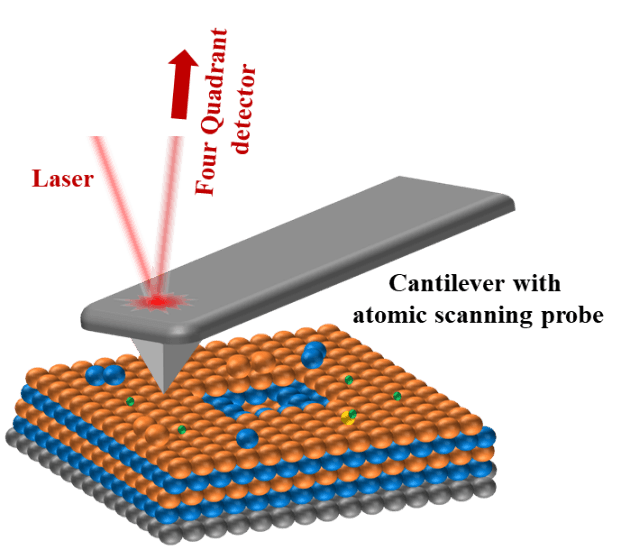DESCRIPTION:
Time-of-Flight Secondary Ion Mass Spectrometry is a surface sensitive technique able to obtain both elemental composition and molecular information on a surface and in-depth. ToF-SIMS has the potential to provide detailed insight into the 3D chemical composition.
The recent developments in ToF-SIMS such as the development of an argon cluster ion beam and of a tightly focused ion beam ensures high performance for organics (polymer, small molecules) and biological materials.
The principle of ToF-SIMS involves detection of secondary ions ejected by the primary ion bombardment. This method enables probing of the chemical composition of surfaces of both inorganic and organic samples.
Using ToF-SIMS analysis, it will be possible to achieve directly the molecular and the elemental information of extreme surface for a large mass range (0 – 10,000 a.m.u) for all elements in periodic table and their isotopes, and molecules with high sensitivity (ppm – ppb). The mapping provides highly localized information with a beam spot size of approximately 100 nm and the capability for depth profiling with sub-nm resolution. Together, these techniques provide a 3-D compositional rendering of the sample. The instrument is capable of analyzing inorganic, organic, conductive, and insulating materials. Sample analysis may require the use of standards to quantify signals and deal with mass interferences and to the variation of ionic yields.
The ToF-SIMS NCS combines a ToF-SIMS with a Scanning Probe Microscope (SPM). The surface initial topography can be measured as well as the topographic changes during the analysis. SPM information analysis provides complementary information about the surface topography and can also be used to measure the physical properties of the analyzed volume. Through the combination of these both techniques accurate in-situ 3D chemical image becomes possible.
ToF-SIMS NCS CAPABILITIES:
- In-situ Atomic Force Microscope (NanoScan VLS-80) is combined with ToF-SIMS instrument. Topographical analysis can be performed in Contact, Intermittent and Non-Contact scan mode including deflection and phase imaging.
- Large mass range spectra are achieved using a pulsed ion beam. The Bi Nanoprobe technology provides SIMS analysis with high-lateral resolution (70 nm) by rastering the field of view in high density of pixels.
- Argon Gas Cluster Ion Source is particularly well-adapted for analysis of high mass molecules, preserving a quasi-intact molecular information and with a high sputter yield for in-depth analysis.
- Dual Source Column (O2 and Cs) is equipped with two of the most polyvalent ion sources for the analysis of inorganic and organic materials, which permits to detect both, positive and negative, polarities of secondary ions.
- Electron flood gun and Oxygen flooding can be used during the analysis, respectively, to compensate the charges and to improve the signal intensity. Both options permit the analysis of any type of materials, conductive or insulating.
- Extended Dynamic Range Analysis permits to record intensities of more than 100 ions per pulse per mass with an excellent linearity.
- Fast Sample Rotation is a new feature, that helps to, limit the formation of ion beam induced surface roughening due to the sputtering.
- Sample Heating and Cooling option allows the temperature-controlled heating and cooling of the sample under analysis from -130°C to + 600°C with a precision of +/- 1°C.
- Transfer Vessel conserves the sample holder (with the samples) from a clean environment, such as a glove box under inert gas atmosphere, to the instrument and vice versa without exposing the sample to ambient air.
ToF-SIMS NCS PERFORMANCES:
- Surface Spectrometry:
- Elements Detected: Full periodic table (including isotopes), plus molecular species (up to 12,000 a.m.u.)
- Sensitivity:
- High mass resolution and accuracy even on insulating samples (typically m/ Δm > 10,000). Particles with the same nominal mass easily distinguished from one another.
- High mass range (m/z: 0 – 12,000 a.m.u). Ions (positive or negative), isotopes, and molecular compounds (including polymers, organic compounds, and up to ~amino acids) can be detected.
- Detection limit: 1 ppm -10 ppb
- Ideally suited for analysis of inorganic, organic or hybrid and biological, conductive/insulating materials
- Surface Imaging:
- High lateral resolution (≈ 70 nm)
- Fast image acquisition (up to 50 kHz pixel frequency) permits a sub-micron imaging to map any mass number of interests
- Field of view from µm2 to cm2
- Depth profiling:
- Depth resolution better than 1 nm
- Sputter speed of up to 10 µm.h-1; the sequential sputtering of surfaces allows analysis of the chemical distribution from each surface of the material revealed during the profile
- Ideally suited for insulators
- 3D Volume Analysis
- Correlative Analysis with in-situ SPM
- Retrospective Analysis. Every pixel of an ion image map represents a full mass spectrum. This allows an analyst to retrospectively produce maps for any mass of interest, and to interrogate regions of interest for their chemical composition via computer processing after the dataset has been instrumentally acquired.






![[feed link]](/wp-content/plugins/rss-just-better/rss-cube.gif)